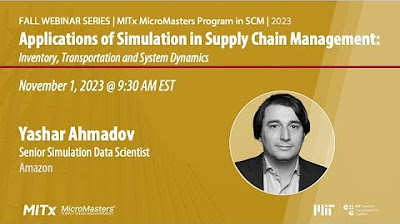Global Supply Chains: How Did All This Stuff Get Here?
Summary
TLDR本次春季系列直播活动由麻省理工学院(MIT)供应链管理MicroMasters项目的课程负责人Paulo Sousa Jr.和Miguel Rodriguez Garcia共同主持。特邀嘉宾Luiz Gosling,AlixPartners的高级副总裁,分享了他在资本密集型行业的供应链经验。Luiz以玩具行业为例,详细解析了从中国深圳到美国最终目的地的全球供应链流程,包括包装、海运、港口操作、铁路和公路运输、仓储管理以及最后一公里配送。他还讨论了影响供应链的宏观因素、技术进步以及管理复杂性所需的软硬技能,为听众提供了深入见解,并鼓励他们思考供应链管理中的成本效率与速度灵活性之间的权衡。
Takeaways
- 🌟 这是MITx供应链管理MicroMasters项目的首次春季直播系列。
- 👋 活动由SC3X课程负责人Paulo Sousa Jr.和SC1X课程负责人Miguel Rodriguez Garcia共同主持。
- 🤗 他们邀请了AlixPartners的高级副总裁Luiz Gosling作为嘉宾演讲,分享全球供应链的见解。
- 🌐 Luiz Gosling拥有超过10年的资本密集型行业项目推动经验,包括运输、物流、基础设施、制造和仓储。
- 🎓 Luiz拥有工业工程学士学位和物流科学硕士学位,以及来自MIT的供应链管理硕士学位。
- 🚢 演讲主题为“这些东西是怎么到这里的”,通过追踪一个产品从中国深圳到美国最终目的地的旅程来探讨全球供应链。
- 🧩 以玩具行业为例,介绍了供应链的复杂性,包括产品的多样性、市场需求的预测和供应链管理的不同策略。
- 📦 讨论了包装和装载的重要性,以及如何通过软件辅助优化集装箱空间和重量的利用。
- 🛳 强调了海运、港口运营、铁路和公路运输、仓储以及最后一公里配送在供应链中的作用。
- 📈 通过实际案例展示了如何通过不同的运输方式和策略来管理供应链,并强调了成本效率和速度敏捷性之间的权衡。
- 🔧 提出了未来供应链管理的挑战,包括技术进步、宏观经济因素、新兴企业的颠覆以及如何制定备选计划B。
Q & A
MITx MicroMasters供应链管理项目包含哪些课程?
-MITx MicroMasters供应链管理项目包含至少两门课程,分别是SC1X(供应链基础)和SC3X(供应链动态),由Paulo Sousa Jr.和Miguel Rodriguez Garcia分别担任课程负责人。
如何参与MITx MicroMasters的现场活动?
-参与者可以通过Zoom的Q&A功能提问,主持人会在整个演讲过程中整理这些问题。
Luiz Gosling在AlixPartners的职位是什么?
-Luiz Gosling在AlixPartners担任高级副总裁。
Luiz Gosling的教育背景有哪些?
-Luiz Gosling拥有工业工程学士学位和物流科学硕士学位,均来自里约热内卢的PUC。此外,他还拥有麻省理工学院的供应链管理硕士学位,并且也参加了MicroMasters课程。
如何优化装载效率以减少运输成本?
-装载效率的优化可以通过软件辅助的装载方法来实现,这涉及到如何将产品装入盒子、箱子或集装箱,并考虑最大化空间和重量利用率。
海洋运输中有哪些关键因素影响成本?
-海洋运输中影响成本的关键因素包括运输率、港口选择、航线的供需关系以及运输的时效性。
为什么说供应链管理既是一门科学也是一门艺术?
-供应链管理既需要精确的数据分析和数学计算,也需要管理人员的直觉和经验,以及在面对复杂多变情况时的决策能力。
如何通过技术提高仓库和配送中心的效率?
-可以通过自动化解决方案、优化的库存管理系统和先进的物流技术来提高仓库和配送中心的效率。
为什么说供应链是一个动态和不断变化的领域?
-供应链是一个动态和不断变化的领域,因为它受到宏观经济因素、新技术、市场变化和新兴企业的不断影响。
供应链管理中的成本效率和速度敏捷性之间如何权衡?
-在供应链管理中,需要根据产品特性、市场需求和战略目标来权衡成本效率和速度敏捷性,以找到最佳的运营模式。
供应链管理职业需要哪些关键的硬技能和软技能?
-供应链管理职业需要的关键硬技能包括数学概念、库存优化、运输管理、成本会计和预测技能。软技能则包括人员管理、简化问题、常识判断和跨学科知识。
Outlines

This section is available to paid users only. Please upgrade to access this part.
Upgrade NowMindmap

This section is available to paid users only. Please upgrade to access this part.
Upgrade NowKeywords

This section is available to paid users only. Please upgrade to access this part.
Upgrade NowHighlights

This section is available to paid users only. Please upgrade to access this part.
Upgrade NowTranscripts

This section is available to paid users only. Please upgrade to access this part.
Upgrade NowBrowse More Related Video

Strategic Sourcing in Supply Chain: Elevating Procurement for Business Success

Supply Chain Risk Management and X shoring

Applications of Simulation in Supply Chain Management

Supply chain network design and inventory management for cost-efficient, in-time, perfect deliveries

Reshaping Business and Supply Chain Strategy Beyond Covid-19 with Professor Yossi Sheffi

MIT Supply Chain Management Master's Program Information Session with Student Panel
5.0 / 5 (0 votes)
